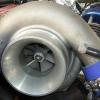Oil Control In Rb's For Circuit Drag Or Drift
Announcements
-
Similar Content
-
Latest Posts
-
So could it be assumed it has been installed intentionally with potentially a power FC boost controller kit?
-
Had my rig on Matt's dyno at PITS the other day. After a few years between tunes I added a few sensors and swapped intercoolers. Result. 553hp at 26psi. Not bad for an FJ20 that was built in 2007. The problem.. It filled the overflow bottle on hard runs which leads me to believe the head gasket isn't sealing. I have a coolant pressure sensor which was reading cap pressure at 22psi and occasionally overrunning to 23/24 psi on deceleration after a pull. It was not spiking. It has arp2000 head studs and a cometic gasket. As its been 18 years in service, I pulled the engine out and head off. Everything looks good but we obviously have an issue. Where I'm at.. Years ago I had the same issue, I checked the stud tension and they were all over the place. Some at 60 to 70 and some up near 90. I nipped them all to 100ft lbs and this stopped the water push until now. I believe this compromised the gasket back then. What do I do? 2 options are.. 1) I bought arp 625+s, which I could put in with a new gasket. Thinking Kameari this time, reassemble and try again. 2) strip the block, get fire rings machined in with copper gasket and try that. I do not want to push it more than 28 to 30psi. I think the turbo will be out by then anyway. (G30-770). My other concern is the long term ability of a copper head gasket. Are they streetable for years? I feel like a new gasket with the new studs will probably suffice, but I don't know. Any thoughts welcome and advice on copper gaskets and fire rings. Thanks!
-
I'm a fan of the JZX110, and the Aristo. Big cruiser cars, and with the factory cars, super comfortable and feel like you're driving an armchair! And the JZ motors are a pretty nice engine too, especially with some basic mods. The import process, and the need to be able to trust people, and the fact there's so many scammers around is what ever puts me off wanting to go through that ordeal!
-
I don't care for these at all, but at least the underside looks straight and not rusty. A good basis for a long life. Many cars from Japan have been lifted with forklifts and f**ked almost irrepairably.
-
Yes, but it's not dumb or dodgy. You can build a perfectly good boost controller from a pressure reg, a relief valve (looks same same as a reg if all from Norgren or SMC, for example) and a check valve. I ran one for years. Only superceded with EBC because I could get one for cheaps and wanted finer control. THis mod is certainly not a sketchy boost mod, provided the boost is kept below the "spin to death" threshold of the turbos.
-








Recommended Posts
Create an account or sign in to comment
You need to be a member in order to leave a comment
Create an account
Sign up for a new account in our community. It's easy!
Register a new accountSign in
Already have an account? Sign in here.
Sign In Now